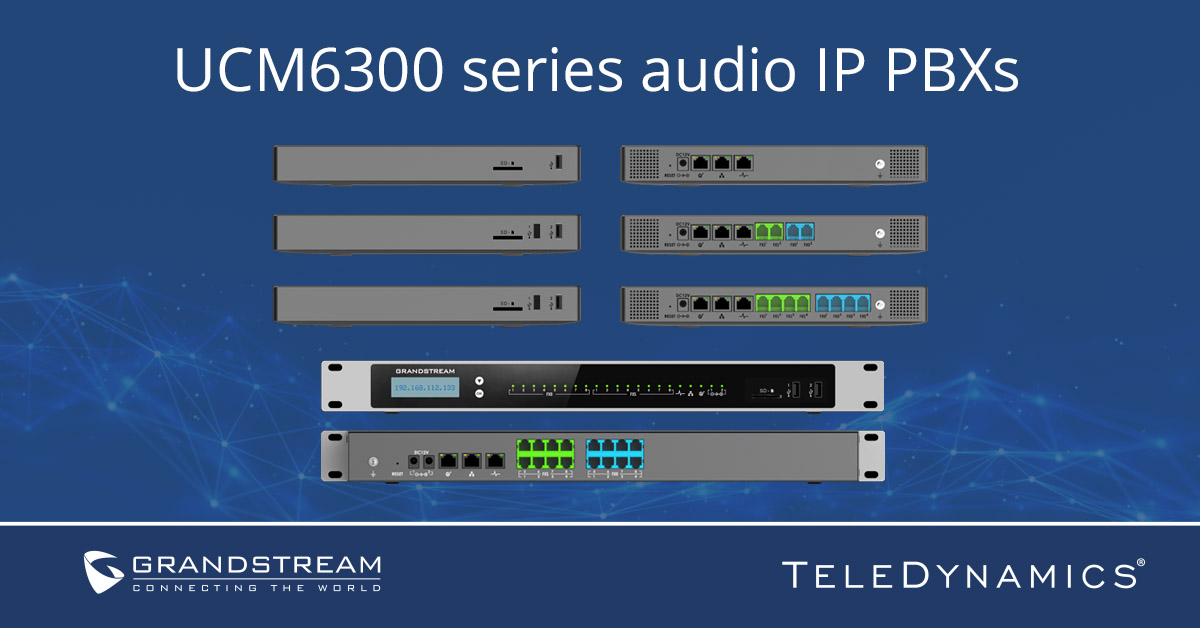TeleDynamics is now a stocking distributor of Boom Collaboration’s line of collaboration devices. In this article, we showcase the company’s profile, as well as review some of the most innovative products they carry, so that you can become more familiar with what they have to offer and how they can benefit your business.
TeleDynamics Think Tank
TeleDynamics now distributes Boom Collaboration devices
Topics: Videoconferencing, Conferencing, Productivity, Collaboration, Boom Collaboration
Product Review
Yeastar’s P-Series PBX System is an innovative and powerful series of VoIP servers that are purpose-built for small to medium-sized businesses. So far, the series has been available as an appliance; that is, a device that gets installed at the physical location of your business. Recently, however, Yeastar has introduced the software edition to the P-Series PBXs, delivering even more versatility and installation options.
We’re excited about this new development, and in this article we showcase the advantages of Yeastar’s P-Series as a whole while also focusing a little more on the advantages of the software edition.
Topics: IP PBX, VoIP, Software Integration, Productivity, Product Review, Cloud, Yeastar
Grandstream's newest GRP carrier-grade IP phones
Product Review
Some of the most important roles within a company require employees to spend a lot of time communicating via telephone. Clear and comfortable communication is vital, and this can only be achieved with the right set of tools, equipment, and services.
Grandstream’s GRP series of carrier-grade IP phones are ideal for employees with high call-volume roles. In this article, we review the two newest additions to the series.
Topics: SIP Phones, Business Telephone System, Grandstream, Productivity, Product Review
5G has been a hot topic in the telecommunications industry over the past few years. Since early 2020, we’ve been hearing more and more about 5G services being rolled out. Every day, a greater number of telcos around the world are marketing and deploying them.
This, then, begs the question: what is the real status of 5G deployment today? Can I truly enjoy all that 5G promises simply because I have a 5G icon in the status bar of my smartphone? We examine these questions and more in this article to get a feel for what’s available now and what you can expect in the future.
Topics: VoIP, Trends, Productivity, Mobile, Cloud, Wi-Fi, IoT, Unified Communications
When they are fully deployed, fifth-generation mobile communications networks are expected to deliver unprecedented speeds and network performance. However, 5G is not all about delivering high bitrates to smartphones. In actuality, other areas of application will benefit most from the proliferation of this innovative technology.
In this article, we take a deeper look at some of these applications and how they are poised to change the way we work, play, and communicate.
Topics: Wireless, VoIP, Trends, Productivity, Mobile, Cloud, Wi-Fi, IoT, Unified Communications
Yealink’s bring-your-own-device (BYOD) solutions
Product Review
More than ever before, connectivity tools of all types are fundamentally changing the way we work. Mobile workforces, collaboration tools, and online business platforms are just some of the innovations that are enabling greater employee efficiency, productivity, and flexibility, while at the same time supporting job satisfaction.
One of the approaches that is making a big difference is the bring your own device (BYOD) philosophy. In this article, we’ll see how Yealink has extended this BYOD approach into the videoconference room.
Topics: Yealink, Peripherals, Mobility (including remote work), Videoconferencing, Productivity, Product Review, Unified Communications, Microsoft, Collaboration, Zoom
Over the past few years, we’ve been hearing a lot about 5G: the potential it promises, the phenomenal levels of network performance it can achieve, and the multitude of applications and services it will deliver. In this article, we review the basics of 5G and how it is poised to change the mobile communications landscape. We also examine the potential benefits it has to offer to enterprise-scale VoIP communications systems.
Topics: QoS, Trends, Mobile, Unified Communications
Grandstream UCM6300 Audio IP PBXs for voice-only communication
Product Review
Grandstream has introduced its audio-only series of IP PBXs for companies that rely heavily on high-quality, feature-rich voice communication and don’t need other types of collaboration platforms like videoconferencing. Keep reading to see why the UCM6300 audio-only series of IP PBXs is a perfect choice for this type of business.
Topics: IP PBX, Business Telephone System, Total Voice Solution, Grandstream, Mobility (including remote work), Conferencing, Product Review, Collaboration
The Worldwide Interoperability for Microwave Access, known simply as WiMAX, is a technology that is often overlooked as an option for wireless connectivity. In this article we’ll shed some light on this often-misunderstood technology and how it can be used to benefit your business in various applications.
Topics: Wireless, Productivity, Wi-Fi, IoT
As we have written about in the past, Yealink offers a wide range of collaboration solutions that bring the Microsoft Teams experience to every workspace and user. In this article we review Yealink’s collaboration kit options that feature Teams-enabled video bars.
Topics: Yealink, Software Integration, Mobility (including remote work), Videoconferencing, Productivity, Product Review, Unified Communications, Microsoft, Collaboration
Welcome to our Think Tank
In this blog you'll read our thoughts on business telephone systems. While a lot has changed in telecom since TeleDynamics was founded in 1981, we remain as committed as ever to delivering the best customer service in the industry.
If you would like elaboration on a specific topic, please let us know in the comments section.
Happy reading and thanks for stopping by!
Receive New Articles by Email

Recent Posts
Posts by Topic
- 5G
- AI
- Android
- Avaya
- Bluetooth
- Boom Collaboration
- Business Continuity
- Business Strategy
- Business Telephone System
- Case Study
- Catalog
- Cisco
- Cloud
- Collaboration
- Communication
- Conferencing
- Cordless
- CPaaS
- Customer Service
- Customer Success Story
- CyberData
- DECT
- E911
- Events
- Facility Management
- Firewall
- Firmware Upgrades
- FoIP
- Gateway
- Grandstream
- Headsets
- Home Security
- IoT
- IP PBX
- Jabra
- Konftel
- Leasing
- Microsoft
- Mobile
- Mobility (including remote work)
- NEC
- Network Design
- Network Infrastructure
- Network Security
- News
- OTT VOIP
- Outsourcing
- Panasonic
- Peripherals
- PoE
- Polycom
- Power Management
- Product Review
- Productivity
- Protocols & codecs
- QoS
- Regulations
- Routers
- SD-WAN
- SIP
- SIP Phones
- Snom
- Software Integration
- Surveillance
- Switches
- Total Voice Solution
- TP-Link
- Trends
- Troubleshooting
- UCaaS
- Unified Communications
- Videoconferencing
- VLAN
- Voicemail
- VoIP
- VoWi-Fi
- VTech
- WAN Technology
- Wi-Fi
- Wireless
- WISP
- Yealink
- Yeastar
- Zoom
















